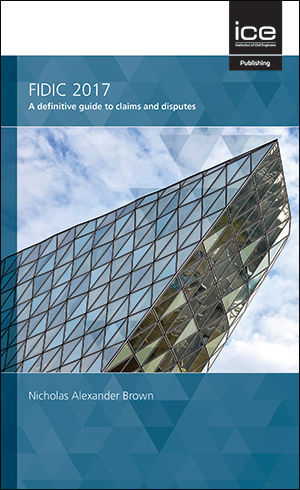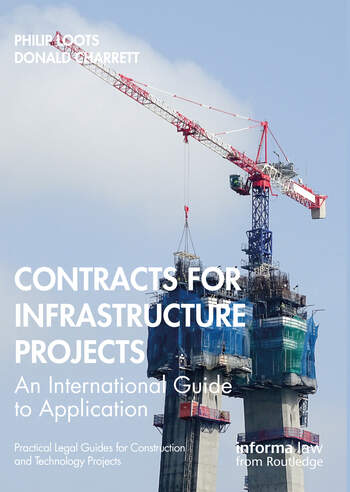CLInt – Book Reviews – September 2022

FIDIC 2017: A Definitive Guide to Claims and Disputes
by Nicholas Alexander Brown
Published by: ICE Publishing, Thomas Telford Ltd 2022
ISBN: 978-0-7277-6531-4
486 pages, £100
Publication date: 15 November 2021
Reviewed by Thayananthan Baskaran and Clement Ling
FIDIC 2017: A Definitive Guide to Claims and Disputes is certainly a welcome addition to the existing texts on the FIDIC Second Edition. The book is brilliantly crafted with a clear objective – to provide a detailed and procedurally focused account of the FIDIC 2017 dispute avoidance and resolution process.
Focused primarily on the FIDIC 2017 Red, Yellow and Silver forms, the book offers a step-by-step explanation of the multi-tiered process concerning claims and disputes, coupled with flowcharts and diagrams to facilitate the understanding of complex topics.
The book comprises 14 chapters. Each chapter begins with a brief abstract and an introduction, followed by concise headings and subheadings which effectively encapsulate the ensuing subject matter. Each paragraph is numbered sequentially through the chapters to enable the reader to locate and extract relevant information quickly. As the author helpfully points out in the Preface, the entirety of the texts may be viewed in seven parts, each dealing with a distinct, yet interconnected topic, presented in a meaningful and logical order.
Chapter 1 introduces the dispute avoidance and adjudication board (DAAB), a FIDIC-prescribed, neutral dispute board comprising an individual or three individuals, as the case may be, of diverse backgrounds and expertise that the parties may appoint to suit their contractual and commercial needs. The overriding purpose of the DAAB is, as its name suggests, to independently, impartially and expertly assist the parties in the avoidance of disputes and in the resolution of those that do arise.
The author explains the concept of a ‘standing DAAB’, one that is constituted at the outset of the contract and remains for the duration of the contract. In addition to its adjudicative role, the standing and peremptory features of the DAAB entail ‘real-time’ assistance to the parties in resolving issues before they become disputes. A contrast is also drawn between a standing DAAB and an ad-hoc dispute adjudication board (DAB). The latter comes into being as and when a dispute arises, and disbands when it gives its decision on that dispute.
Chapters 2 and 3 explore the concept and potential sources of a ‘claim’, generally and under the FIDIC Second Edition specifically. Due consideration is also given to the sub-concepts of ‘entitlement’ and ‘relief’, with reference to pertinent sub-clauses of the contract. The chapters comprehensively and lucidly explain how a claim is procedurally initiated, notified and sustained, followed by the consequences of a failure to adhere to such procedure.
A claim is often the main contractual avenue through which potential pecuniary or non-pecuniary entitlements and remedies may arise. The contract specifically prescribes four types of claims, namely: (1) additional payment (or reduction in the contract price); (2) an extension of the defects notification period for the employer; (3) an extension of time for the contractor; and (4) a catch-all category of any entitlement or relief for either party. Type 1 to type 3 claims are subject to a slightly different set of procedure and requirements from that applicable to type 4 claims, insofar as the roles of the engineer or the employer’s representative, and the details to be included in the claim are concerned. This is all clearly explained by the author in a manner that is readily understood and practical.
Chapter 4 examines the attempt that must be made by the parties at an amicable settlement of the claim by way of consultation and agreement. This is followed by a notice of the parties’ agreement, given by the engineer or employer’s representative if the parties manage to achieve an amicable resolution of the claim. Subsequently, Chapter 5 considers the procedure for the recognition and enforcement of a binding settlement agreement between the parties resulting from consultation, and discusses the remedies for non-compliance with such an agreement.
Chapters 6 and 7 account for the next steps that must be taken by the engineer or employer’s representative to determine notified claims in the absence of the parties’ amicable settlement, and subsequently, the various ways in which to enforce that determination, be it provisionally binding or final and binding. The absence of an amicable settlement can stem from the parties failing to reach an agreement by consultation within the time prescribed by the contract, or from the parties notifying the engineer or employer’s representative that no agreement can be achieved. If either party is dissatisfied with the aforesaid determination, that party may give a notice of dissatisfaction (NOD) of the determination in accordance with the form and timing set out in the contract.
The remaining chapters of the book centre around the process by which a dispute may be resolved by way of an interim yet binding decision of the DAAB. Subsequently and similarly, a dissatisfied party may, by giving a NOD of the DAAB’s decision, take the dispute to arbitration pursuant to the ICC Arbitration Rules for a final determination of the dispute. The chapters also comprise a detailed explanation on the procedural and substantive rules applicable to the DAAB and arbitral proceedings, drawing on a vast number of illustrative cases and materials from various legal systems and jurisdictions. Perhaps, most significantly, the author affords the reader a definitive account of the possible routes and procedures through which a DAAB decision and an arbitral award may be enforced.
The contents of this book are thoughtfully put together and are indeed a definitive guide and of practical assistance to anyone contemplating making a claim and navigating the requisite procedures under the FIDIC 2017 forms, a process now made more readily comprehensible by the advent of this insightful work.

Contracts for Infrastructure Projects: An International Guide to Application
by Philip Loots
and Donald Charrett
Published by: Routledge, 2022
ISBN: 9781032074290
848 pages, £200
Publication date: 19 May 2022
Reviewed by Tjaart van der Walt SC, Sandton, South Africa
After more than 35 years in legal practice I have become somewhat desensitised by the proliferation of new publications, particularly in the field of construction law. Many are what my friends in academia refer to as carrying dead bones from one grave to another.
But, having read Construction Contracts for Infrastructure Projects from cover to cover, I am entirely resensitised.
The learned authors Philip Loots and Dr Donald Charrett need no introduction to anyone with an interest in the law and practice of construction. Their impressive biographies are contained on pages xvi and xvii of the publication. Their joint and separate experience and insight drawn from decades of global inter-disciplinary exposure, theoretically and practically, shine brightly throughout this scholarly treatise. It constitutes an impressive compilation of the legal principles and practical considerations governing the relationships between parties from different jurisdictions in the modern-day world of international infrastructure projects. It addresses the challenges facing the role players and those advising and representing them, and the confluence between common law and civil law jurisdictions. It displays a diligent, committed analysis of the complexities of the law and practice relevant to construction projects globally. It does so in a manner within the reach of a broad spectrum of readers. The publication bears testimony to the authors’ intellectual discipline and deep understanding of the law and practice relevant to all aspects of construction contracts.
This publication is bound, over the years to come, to earn a special place in my library among a few select, dog-eared, iconic stalwart textbooks.
The publication comprises over 800 pages of meticulously researched text in plain language. More than 1,200 judgments from around the globe are referred to. It includes relevant portions of legislation from more than 50 international jurisdictions, all contained in a neatly laid out and user-friendly publication, supplemented by useful case studies, tables, illustrations and schedules.
The book deals with the following well-considered and logically sequenced topics in 29 chapters:
• an introduction
• contract law
• construction contracts
• lex constructionis
• entry into a contract
• general provisions
• the employer
• the engineer
• the contractor
• subcontracting
• design
• staff and labour
• plant
• materials and workmanship, commencement, delays and suspension
• planning and programming
• tests on and after completion
• employer’s taking-over
• defects after taking-over
• measurement and valuation
• variations and adjustments
• contract price and payment
• termination by the employer
• suspension and termination by the contractor
• care of the works and indemnities
• exceptional events
• insurance
• employer’s and contractor’s claims
• dispute avoidance and resolution
• the impact of ICT on construction contracts.
There is an alphabetically tabulated 50-page glossary of terms which guides the reader to the term, its meaning and in which section it is defined.
There are three appendices dealing with matters for consideration when drafting a construction contract, risk factors in the construction of infrastructure projects, and global claims.
The following quotation from the foreword written by the Honourable Wayne Martin AC QC is appropriate:
‘This book responds to the need created by the globalisation of the construction industry. Lawyers advising participants in that industry can no longer rely upon domestic texts which deal only with the laws of a particular jurisdiction. In this seminal work they will find a truly cosmopolitan compilation of the sources of law which govern the rights and obligations in transnational construction projects.
‘The authors comprehensively develop the thesis earlier propounded by others to the effect that it can now be said that there is a coherent body of international law applicable to construction which can be regarded as a division of the lex mercatoria (international merchant law) and described as lex constructionis.’
I am of the view that Contracts for Infrastructure Projects is an indispensable addition to the library of everyone involved with construction contracts, whether as a lawyer, employer, contractor, engineer, claims consultant or dispute avoidance or resolution practitioner. It will undoubtedly be an invaluable resource for construction law students.